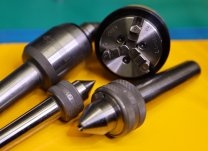M.B. Naegle
Diamond
- Joined
- Feb 7, 2011
- Location
- Conroe, TX USA
With the Hydraulic vise: I have a few milling vises built in similar fashion and love them. Two made by Saunders in England, and the other has no name but I suspect it's an old Hilma or other German/Swiss. I've never had to take the screw mechanisms apart on them so I don't know how complicated they are, but the design makes for an incredibly smooth operation that puts a ton of force into the clamp with little effort.
Thanks for the thread. Its fun to see what's around "over there", more than what gets brought in for our market over here. I don't want to derail your thread with the politics of it all, but I've always admired how the Germans and Japanese went from the ashes of war to being THE world leaders in so many aspects of technology and manufacturing.
Thanks for the thread. Its fun to see what's around "over there", more than what gets brought in for our market over here. I don't want to derail your thread with the politics of it all, but I've always admired how the Germans and Japanese went from the ashes of war to being THE world leaders in so many aspects of technology and manufacturing.


 Yeah, used to shave a lot more. Nowadays I just use 'em for a trim. But I still enjoy razor and knife sharpening. Sort of a zen thing; it's relaxing.
Yeah, used to shave a lot more. Nowadays I just use 'em for a trim. But I still enjoy razor and knife sharpening. Sort of a zen thing; it's relaxing.


